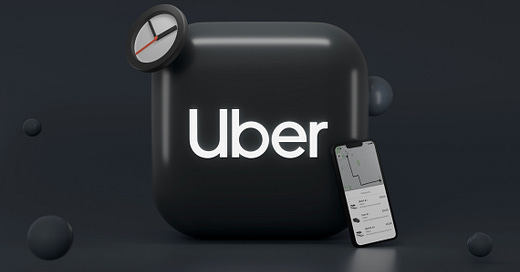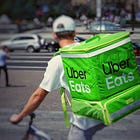Robotaxis vs Uber: Why the Disruption Might Be Overstated
Analyzing why the rise of self-driving taxis may not spell the end for Uber
There has been a lot of talk lately about robotaxis (Waymo is growing fast and Tesla made huge announcement about Robotaxis) and a lot of it spells doom for Uber. The story goes like this: driverless cars are coming, they will be cheaper and safer, and that means Uber’s business is toast.
But let’s pause for a second. That logic might make sense at first glance, but it misses something really important: Uber is not a taxi company.
In fact, if robotaxis are going to disrupt anything, it is not Uber, it is the drivers. Uber, on the other hand, might actually be well-positioned to benefit from the shift. Here is why.
Uber's core business is a marketplace, not a fleet
I published a deep dive on Uber a few months ago. If you are curious about the company and the stock give it a read!
At its heart, Uber is a two-sided marketplace that connects supply and demand across three businesses:
Mobility. Ride-hailing via human drivers (and potentially autonomous vehicles). It is the main activity and the most famous one
Delivery. Food and grocery logistics via Uber Eats
Freight. B2B logistics and freight forwarding
Uber’s role is to match buyers (riders, eaters, businesses) with sellers (drivers, couriers, logistics providers). It does not own or operate a fleet, nor does it rely on any single type of vehicle technology. This makes Uber structurally different from traditional taxi companies or even companies that may operate and own their own robotaxi fleets.
What truly defines Uber is its platform, one that gains strength as more users and service providers join. This network effect (network of seller but mainly network of buyers) is its core competitive advantage and the real moat around the business.
Robotaxis don’t eliminate the need for a platform
Sure, they could dramatically lower the cost of a ride by eliminating the driver. And that is a game changer. But even if the car drives itself, you still need:
A platform people trust
A way to match supply and demand
Routing, pricing, payments, customer service
That is exactly what Uber already does. It is not just about moving a car from point A to B, it is about managing millions of transactions and relationships at scale.
So while robotaxis are bad news for drivers, they do not automatically cut Uber out of the equation. If anything, Uber can become the interface for this new mode of transport, just like it is done with human drivers. It will the “distribution side” of the global value chain.
And that is not theoretical. Uber has already started:
It partnered with Waymo, integrating its self-driving cars into the Uber app
It has the infrastructure to plug in robotaxis from any provider
Uber’s superapp strategy
Another angle often overlooked in the robotaxi discussion is Uber’s ambition to become a superapp, a single platform that bundles multiple services into one seamless user experience.
In markets like Asia, superapps like Grab or Gojek have shown how powerful this model can be, combining mobility, food delivery, payments, and more. Uber is following a similar path, with deep integration across rides, Eats, grocery, and even transit options in some cities. This strategy strengthens user engagement and increases customer lifetime value, as users rely on the app for more aspects of daily life.
Robotaxis do not disrupt this playbook, they actually fit into it.
What if other companies created platforms like Uber?
One valid concern is the possibility that companies like Alphabet (via Waymo) or Tesla, which are at the forefront of autonomous driving, could go beyond just supplying robotaxis and build their own end-to-end platforms to compete directly with Uber.
If these tech giants were to create consumer-facing apps with their own network effects, brand loyalty, and bundled services, they could become formidable rivals (even if it is not that easy!). In that case, Uber would not just be integrating robotaxis, it would be competing with the companies making them. This dynamic could shift the power balance in the value chain.
Moreover, the emergence of large-scale robotaxi fleets could significantly increase the bargaining power of suppliers, as described in Porter’s Five Forces. If companies like Waymo or Tesla control both the technology and the vehicles, they gain leverage over platforms like Uber, potentially demanding higher revenue shares or restricting access altogether. This could lead to pricing pressure, thinner margins.
But even in that scenario, it would not spell the end for Uber. The company’s real strength lies in its multi-service ecosystem: rides, food delivery, groceries, freight logistics, and even integrations with public transit, all accessible through one unified app. This breadth of services increases customer retention and engagement, making the platform more resilient to competitive pressure in any single vertical. So while new entrants might chip away at Uber’s dominance in mobility, they are unlikely to displace the entire ecosystem it has built, at least, not any time soon.





Waymo already has its own app: Waymo One. Most rides happen through it, not via Uber. I think you overestimate the effort to create and manage one. It's rather simple (technically speaking), a trivial task in comparison to developing the self driving technology.
It's not a question of whether Waymo will directly compete with Uber, but whether buyers will migrate. I believe it boils down to how many competitors will end up providing robotaxis. If it's just one or two, why open Uber when you already know you want a Waymo or a Tesla Robotaxi? The custom apps will definitely have better integrations (e.g. control the music in the car). Uber is only advantaged if there end up being many players in the space and have to compete on price / for buyers.
I personally believe there won't be many players in the space. 2, max. One with a clear better safety track record, and one which - lacking better safety record -, will have to price itself lower.
Interesting read, if anyone is interested I did a more in depth analysis over on my page https://rootcapital.substack.com/p/why-uber-is-perfectly-positioned?r=hhk7e